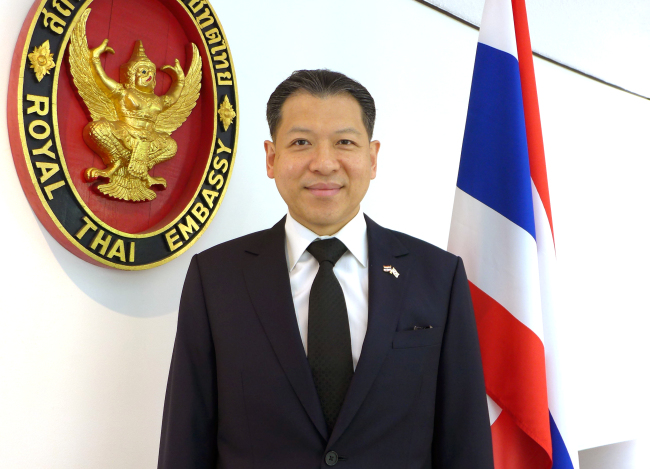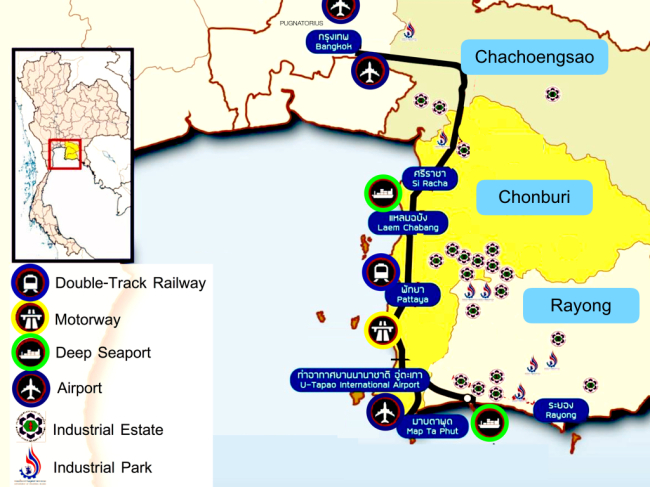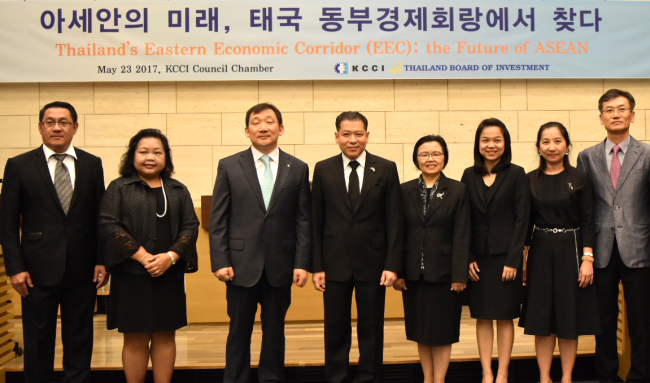The Eastern Economic Corridor in Thailand is an axis of industrial estates southeast of Bangkok. It is the Thai government’s flagship project to turn the country into the hub of the region’s advanced industries and commercial networks.
Comprised of the Pin Thong Industrial Estate, Hemraj Eastern Seaboard Industrial Estate, Amata City Industrial Estate and Rayong Industrial Estate, the scheme integrally underpins the “Thailand 4.0” economic restructuring initiative, aimed at spurring entrepreneurialism in information and communication technology, smart farming, advanced manufacturing, tourism and creative industries.
According to Thai Ambassador to Korea Sarun Charoensuwan, the project, which has secured a $43 billion budget for the first five years, presents timely opportunities for Korean firms as they look toward the Southeast Asian markets, in light of China’s purported economic retaliation following Korea’s deployment of a US anti-missile defense system in the country.
“Fundamentally, the project’s real benefit is its location,” he said in an interview at the Thai Embassy in Seoul. “It’s a very realistic project because most infrastructures are already in place, and we just have to connect the missing links. It’s not starting from scratch.”

Thai Ambassador to Korea Sarun Charoensuwan (Joel Lee/The Korea Herald)
Opportunities lie in upgrading and adding new infrastructures to seamlessly connect and complete the whole system, he added. “That’s the whole idea.”
By refurbishing airports and seaports and constructing high-speed railways, motorways and roads between the estates and linked to Bangkok, the area-based development project targets building new cities, boosting tourism, strengthening infrastructure and invigorating businesses.
“This is where Korean companies can jump in,” the envoy said, adding the presence of Samsung, Posco and LG could provide assurance to potential investors. “We also need more knowledge-based research and development functions, so welcome related investments.”
As promising future industries, Bangkok has recently announced its first “S-Curve” industries of next-generation automobiles, smart electronics, medical and wellness tourism, smart farming and biotechnology and sustainable food, to be followed by the second “S-Curve” sectors of robotics, aviation and logistics, biofuel and biochemical, digital technology and medical hub development.
“ASEAN is scrambling to build infrastructure,” the diplomat said, referring to various physical connectivity-enhancing projects taking shape across the Association of Southeast Asian Nations. “As the world becomes smaller and more interconnected, infrastructural connectivity would benefit everyone by expediting the movement of capital, manpower and technology.”

Thailand's Eastern Economic Corridor (Pugnatorius)
Referring to the “One Belt, One Road” infrastructure and international development initiative by China, the ambassador said Thailand welcomed the strategy, particularly as it helps develop the neighboring economies of Cambodia, Laos, Myanmar, Vietnam and Malaysia.
Currently, high-speed rail lines are being developed from Bangkok to Rayong, and double-track railways are in the works connecting the northeastern province of Nong Khai and Bangkok, with plans for extension to the deep south near Malaysia.
Noting that enhancing ties with ASEAN is Thailand’s cornerstone policy, Charoensuwan said his government is committed to “not leaving anyone behind” in development in the spirit of “prospering thy neighbors.”
“We will talk together rather than walk faster than others,” he said of his government’s approach. “We want to develop together so that our growth collectively benefits. Once border areas are safe, secure and prosperous, our neighboring countries with bigger purchasing powers will buy more Thai goods and services.”

Participants pose at an investment seminar on Thailand's Eastern Economic Corridor at the Korea Chamber of Commerce and Industry on May 23. (Thai Embassy)
To help narrow the wide development gaps between neighboring countries, Thailand has undertaken projects to upgrade their infrastructure and regulatory systems.
Charoensuwan encouraged more Korean investment in these schemes, noting that a substantial number of Korean businesses have already made their presence there. Thailand can be a test bed for the larger ASEAN market, he argued, adding the country offers manpower and knowledge of local markets.
Regarding the new administration of President Moon Jae-in, the ambassador highlighted that Korea and Thailand have always maintained a close and cordial partnership, but he urged for more attention given to ASEAN.
“ASEAN is a developing region with over 600 million people, and will be an even more integrated and interconnected market and production base,” he said. “Tourism exchanges are significant with 10 million people traveling between Korea and ASEAN each year. This is a strong base from which to expand our relations to the next level, targeting sustainable economic cooperation.”
By Joel Lee (
joel@heraldcorp.com)






![[From the Scene] Monks, Buddhists hail return of remains of Buddhas](http://res.heraldm.com/phpwas/restmb_idxmake.php?idx=645&simg=/content/image/2024/04/19/20240419050617_0.jpg&u=20240419175937)

